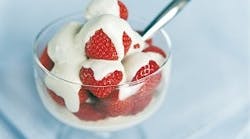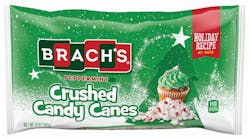Greek yogurt was pumping up a competing breakfast category, so Post and others reasoned it might also prop up cereal sales.
If you haven't yet realized that Greek yogurt is jumping categories consider Honey Bunches of Oats Greek Honey Crunch, a breakfast cereal from Post Foods. It features “four nutritious grains,” 33g of whole grains and 5g of protein per serving (similar to other healthful cereals, including Wheat Chex).
With its nutrient density and clean label appeal, Greek-style yogurt has clobbered the yogurt case, now outselling all other types of yogurt combined. And it just might be ready to go after anything else consumed in the morning.
“Consumer awareness of — and therefore demand for — high-protein products with an authentic Greek-style flavor has increased in the last couple of years,” says Vicky Fligel, business development manager of functional dairy at Glanbia Nutritionals, Fitchburg, Wis. “Greek yogurt in particular has experienced sustained success thanks to its low fat, high protein, low sugar and minimally processed profile.”
Food makers including Post and rival Kellogg Co. figure that same appeal can help reinvigorate sluggish breakfast food sales, as long as the products deliver on the promises. So Greek yogurt ingredients are showing up in breakfast bars, cereals, cream cheese and dips. Fligel's employer recently introduced a Greek yogurt powder that makes it easy for food processors to add authentic flavor and nutrition to products that are labeled Greek.
Elsewhere in the dairy category (and in dairy-ingredients) there has been some subtle fine-tuning involving things like colors and flavors. Natural colors are finding their way into more formulas, and flavors are becoming more bold and daring.
Greek migration
Greeks are moving out of the yogurt case to conquer other dairy territories. Last year, Litehouse Foods Inc., Sandpoint, Idaho, added three bold flavors to its Greek yogurt-based Opa salad dressing line: Jalapeño Ranch, Kalamata Feta and Roasted Pepper. Also last year, in the healthy snack category, plum cooperative Sunsweet launched Greek Style PlumSweets, chewy, diced, dried plums on the inside with a Greek yogurt coating.
A year earlier, Kraft introduced Breakstone Greek Style Sour Cream. Phoenix-based Inventure Foods, under a licensing agreement with Jamba Juice Co., created Jamba At Home Smoothies, combining non-fat Greek yogurt with on-trend superfruits pomegranate and acai (as well as other antioxidant-heavy berries). T. Marzetti Co. and others have slipped it into dips.
And just about every ice cream maker has brought Greek yogurt to the ice cream and novelty categories.
Under its Green Mountain Farms brand, Franklin Foods, Enosburg Falls, Vt., has gotten a good deal of attention with its Greek Cream Cheese. Food columnist Florence Fabricant wrote about the product for the New York Times recently, noting is has live cultures, 4g of protein in a tablespoon serving and about a third as much fat as standard cream cheeses.
Years back, yogurt became a healthful replacement for chocolate coatings. So why not Greek yogurt? And it doesn't have to be white.
While such a product can be made by substituting fresh Greek-style yogurt for some portion of the fresh cream and milk in a formula, other products, such as the Special K Protein Bar (which now includes a Greek Yogurt & Fruit flavor) might be more likely to benefit from a powdered yogurt product, such as Glanbia Nutritional's OptiSol 1061 Greek Yogurt Powder. The company has been offering the ingredient in the U.S. for about a year and showcased it at last year's IFT Food Expo.
It is made from real cultured Greek-style yogurt and its composition is 60 percent protein, which is about 10-15 percent higher than other milk and yogurt powders.
It also delivers a clean-label positioning with an ingredient declaration of “cultured skim milk, milk protein concentrate,” as well as high levels of calcium, potassium, phosphorous and other milk minerals, plus only five percent fat.
“In essence what we are doing is making a Greek style yogurt and drying it into a powder form,” Fligel said. “We are fortifying it prior to drying it.”
Glanbia says the products can be included in a multitude of applications, including fresh dairy products, beverages, bars, cereals, desserts, sauces and dressings. It offers minimal viscosity impact in drinkable yogurts for a better organoleptic experience and can also be used in the core, layers and coatings of nutritional bars.
Fligel said there hasn't been a lot of work done yet, but Greek-yogurt powder might also find a home in savory snack products and could be used in dairy-based dips. With allowances for additional acidity, a reconstituted Greek yogurt can replace some of the sour cream in most formulas.
She also noted that the product works well with a variety of other protein ingredients and can be used in concert with whey or soy protein or nuts to reach mid-level protein concentrations that appeal to consumers.
“It would certainly work by itself for something in the range of 10 grams of protein, but if you wanted 20 grams of protein in a bar you would utilize something like whey or milk to get to 20 grams,” Fligel said.
In its literature, Glanbia notes that OptiSol 1061 helps to improve texture, flavor and formulation processes. And its powder format offers numerous convenience benefits. The product is made from non-rBST milk at Glanbia's two U.S. plants.
Flavors and colors
With its tart profile, Greek yogurt has lent itself to flavors that were sometimes scarce in dairy. Chobani Inc. New Berlin, N.Y., has introduced several citrus flavors, including Lemon (with lemon zest), Blood Orange, Key Lime and Key Lime Crumble (in the Flip line). Chobani also has introduced an indulgent line featuring three chocolate and fruit flavors, and the yogurt-leader's Chobani Kids line features kid-ready flavors that include Grape and Watermelon.
Colors always play an important role in dairy products too. The food coloring business has been leaning toward natural colors for years, beginning in Europe. Among the latest trends in Europe is what Thomas Christensen, global marketing manager for dairy and phytonutrients with Chr. Hansen, Milwaukee, calls "coloring foodstuff." And he says it's particularly prevalent in yogurts and other cultured dairy products.
“In the U.S., you would typically label something vegetable concentrate,” Christensen says. “This could in practice be both a natural color and a coloring foodstuff.” But as colorants are currently defined in the U.S., a move toward foodstuffs would offer little clean-label benefit in the U.S., he adds.
In cheesemaking, processors are shifting from use of annatto toward beta-carotene for those buttery hues, and the change has to do more with an important co-product than with cheese itself. “The main focus is actually on the whey and (its use) in infant formula and the fact new regulations do not allow [the residual] color” in infant formula, Christensen says.
Color is less likely to migrate from colors made with beta-carotene, and Chr. Hansen has a proprietary colorant product that will allow for clean whey. In addition, beta-carotene is a natural component of cow's milk that can be listed on a nutrition panel as provitamin A.
Finally, many dairy-based products and food components receive some help in achieving their comfortable flavors and textures through the use of texturants including starches and hydrocolloids. Ingredion Inc. Westchester, Ill., offers clean-label native starches that can replace bulk in lower-fat dairy products and improve overall texture. The company has demonstrated those attributes with a spinach gorgonzola Greek yogurt dip. The starch has moderate process tolerance and is easy to disperse in a dairy base.

